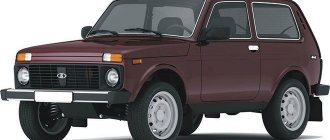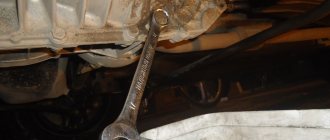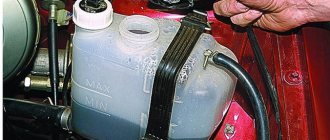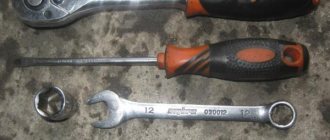- home
- Brands
- VAZ
24.11.2020
VAZ-2121 is the first Soviet and Russian SUV, produced from 1977 to 2006. Newer versions of this model are still relevant today under the name Lada 4x4. Execution 2121 is considered the first version of the original Niva from 1977. This car is considered one of the founders of compact crossovers with a monocoque body. According to official data, the VAZ-2121 is AvtoVAZ’s most successful export car in history.
Volumes of oil and liquids NIVA
OIL AND LIQUID VOLUME for NIVA cars
| Refillable system | Volume, l | Oils and liquids |
| Fuel tank (including reserve) | 42 (65*) | Motor gasoline with octane number 93, 95** |
| Engine cooling system (including interior heating system) | 10,7 | Latest recommendation AvtoVAZ G12 |
| Engine lubrication system (including oil filter) | 3,75 | Motor oils (with API quality level: SG, SH, SJ, SL,SM, SN) from –20° to +45°С SAE 15W-40 from –25° to +35°С SAE 10W-30 from –25 ° to +45°С SAE 10W-40 from –30° to +35°С SAE 5W-30 from –30° to +45°С SAE 5W-40 |
| Gearbox housing | 1,6 | Transmission oils GL-5 and viscosity 75W-90 |
| Rear axle housing | 1,3 | Transmission oils GL-5 and viscosity 75W-90 |
| Steering gear housing | 0,18 | Transmission oils GL-5 and viscosity 75W-90 |
| Transfer case housing | 0,79 | Transmission oils GL-5 and viscosity 75W-90 |
| Front axle housing | 1,15 | Transmission oils GL-5 and viscosity 75W-90 |
| Hydraulic clutch system | 0,2 | DOT-4 brake fluid |
| Hydraulic brake system | 0,535 | DOT-4 brake fluid |
| Windshield and headlight washer reservoir | 2,8 | Water/windshield washer fluid |
| Rear window washer reservoir | 2,0 | Water/windshield washer fluid |
| Power steering reservoir | 1,7 | Liquid Pentosin CHF11S |
* For VAZ-2131 cars and its modifications. **For vehicles with fuel injection system equipped with an exhaust gas converter
Source
Main elements of the system
The largest and most basic element is the fuel tank, but the total number reaches sixteen. Their volumes vary greatly.
- They are necessarily included in the engine cooling and lubrication systems.
- Axle housings and gearboxes are also extremely important for safety during travel.
- Chevrolet Niva filling tanks include power steering systems and hydraulic brake lines, front and rear shock absorbers.
- An integral part are tanks for windshield washer and air conditioning.
What oil should I use in the LADA Niva transmission?
09/29/2020 VAZ Niva (Lada 4x4) is a compact off-road vehicle, available in three and five-door body styles. Production of the model began in 1977. In the 2010s, under the leadership of AvtoVAZ President Bo Andersson, an updated version of the Urban was developed with modified bumpers and improved finishing. In 2020, the car received a new front panel, adapted to modern safety and comfort requirements. However, the design remains the same. The original name “Niva” was relevant until 2006 in connection with the release of the more modern Chevrolet Niva SUV. However, in 2022, AvtoVAZ regained the right to use the Niva trademark, which previously belonged to the General Motors concern.
Modifications
Since 1994, the manufacturer has adjusted the parameters of motor 21214 several times:
- 21214-10 (2002) – Euro-0, the first version had central gasoline injection;
- 21214-20 (2006) – Euro-2 controller Bosch MP 7.0, pairwise variable injection;
- 21214-30 (2008) – Euro-3, without power steering;
- 21214-41 (2011) – Euro-4 for the Russian Federation and Euro-5 for export, power steering, welded manifold;
- 21214-22 – Euro-2, hydraulic supports for valve levers appeared;
- 21214-31 – Euro-3, welded steel manifold, power steering pump;
- 21214-32 – Euro-3, power steering, cast iron manifold, flywheel for 215 mm clutch diameter;
- 21214-33 – Euro-3, cast iron manifold, hydraulic booster;
- 21214-34 – Euro-3, cast manifold without power steering.
Power steering 21214
Modification 21214-28 had a volume of 1.8 liters due to the larger piston stroke of 84 mm. The engine power reached 92 hp. s., and the torque is 159 Nm. In total, a little more than 69 engines of this type were produced.
How much oil to fill in Niva
First generation 2121, since 1977
Despite the lightweight monocoque body and structural basis from the VAZ-2106, the Niva has impressive off-road capabilities largely due to its short wheelbase and almost non-existent body overhangs, which ensures high approach and departure angles. The car also has permanent all-wheel drive and is equipped with a transfer gearbox. Under the hood there is a non-alternative 1.7 petrol engine with a power of 81 hp. s., aggregated with a five-speed manual transmission. In 2022, AvtoVAZ improved the car's suspension - installed gas-filled shock absorbers and bearings in the front hubs, and also introduced independent mounting of the front axle gearbox. Since 2022, the car has been officially sold as Lada Niva.
- Transfer case oil: volume – 0.79 liters, tolerance and viscosity: API-GL-3-4; SAE 75W-90
- Rear axle gearbox oil: volume 1.3 liters; front - 1.15 liters; tolerance and viscosity: API-GL-3-4; SAE 75W-90
Also read: Oil for manual transmission VAZ-2106
How much antifreeze or antifreeze is needed in the car cooling system:
- VAZ 2101 - 8 liters;
- VAZ 2102 - 8 liters;
- VAZ 2103 - 8.6 liters;
- VAZ 2104 - 8.5 liters;
- VAZ 2105 - 8.6 liters;
- VAZ 2106 - 8.6 liters;
- VAZ 2107 - 8.6 liters;
- VAZ 2108 - 7.8 liters;
- VAZ 2109 - 7.8 liters;
- VAZ 21099 - 7.8 liters;
- VAZ 2113, 2114, 2115 - 7.8 liters;
- VAZ 2110, 2111, 2112 - 7.8 liters for both 8 and 16 valve engines;
- VAZ 21213 “NIVA” - 10.7 liters;
- VAZ 2111 “OKA” - 4.8 liters;
- Lada Granta VAZ 2190 - 7.8 liters;
- Lada Kalina VAZ 23009 - 7.84 liters;
- Lada Priora - 7.84 liters;
- Lada Vesta - 7.84 liters;
- Lada Xray (X Ray) - 7 liters.
All-season oils
Due to their thickened nature, these lubricating compositions are non-Newtonian fluids, and their viscosity depends not only on temperature, but also on the shear rate gradient. The indicator is determined by the ratio of the speed of movement of the friction surfaces relative to each other to the gap between them, which is filled with oil. Consequently, the properties of multigrade oils depend on the condition of the thickeners contained. Their viscosity decreases as a result of the destruction of thickening additives. Regardless of the content of the latter, the kinematic viscosity of oils is similar to the viscosity of seasonal oils in the optimal temperature range. As the temperature decreases, thickened oils become thinner.
Gas tank characteristics
Niva Chevrolet fuel tank capacity is almost 60 liters. The technical description for the car indicates the exact figure for this indicator - 58 liters. Such a tank is characterized as large, which adds additional convenience when operating the vehicle. The car consumes AI-92 or Premium AI-95 gasoline at a consumption of 8-9 liters per 100 km. Which is the average for similar models.
Features of the Chevrolet Niva gas tank
- The tank is located directly under the rear seat;
- In the upper plane there is a small hatch, below which there is a fuel pump;
- The fuel refueling indicator is located on the dashboard of the car. It helps control the required amount of gasoline for refueling.
What oil to use for VAZ Niva
Original
Three types of transmission oil are poured into the crankcase of the front and rear axles, as well as the transfer case of the VAZ Niva car - mineral, semi-synthetic or synthetic. For cars of recent years of production, semi-synthetic or synthetic is recommended. As for viscosity, SAE 70W, 80W or 85W is suitable for winter use, and SAE 90, 140 or 250 is used mainly in summer. Moreover, the most popular in the Russian environment is an all-season transmission with SAE 75W-80, 80W-85, 80W- 90 or 75W-90.
Unoriginal
To service the transfer case, gearbox and axles of a VAZ Niva, it is better to choose oil from trusted manufacturers - Mannol, Total, Eneos, ZIC, Castrol, Kixx, etc. Regarding the type of viscosity, it should be noted that synthetic oil is more fluid, suitable for cars of recent years release. Accordingly, mineral water or semi-synthetics are recommended for older cars. It has a relatively thick consistency, which means there is less chance of leaks in the presence of microcracks or gaps between contact pairs. Even when choosing an oil, pay attention to the current tolerance indicators API-GL-3, 4 or 5. The higher the indicator, the more oil additives. In the case of Niva, you can opt for API-GL-5. Below are suitable oils for the transfer case, axles and gearbox of the VAZ Niva.
- Liqui Moli 75W-90 GL-4/5
- Chevron 80W-90 GL-5.
Injection 21214 eats more than VAZ 2121
Changing the oil in a Priora automatic transmission
Interior of a domestic SUV
The injector on 21214 has the following operating scheme: data on air flow, crankshaft movement, coolant temperature, engine detonation, fuel consumption, voltage in the on-board network, etc. is received from vehicle components to a number of sensors. After receiving the information, the control unit gives signals about the order of fuel supply, the operation of the ignition system, the diagnostic system, the operation of the idle air control. The injector changes injection parameters depending on the data received.
This system includes such components as sensors, a controller, the injector itself (nozzles), a fuel pump, and a pressure regulator. In it, the pump supplies fuel, the pressure regulator maintains the difference between the pressure in the injectors and the air gap in the intake manifold. And the ECU processes the information received from the sensors.
Injection engines of Niva 21214 cars, if not properly maintained, lose their efficiency, increasing fuel consumption, and often begin to stall. As a rule, the problem lies in dirty engine injectors, which cause poor mixture formation and atomization of gasoline. Cleaning the injectors can be done independently by purchasing additional materials worth about 500 rubles (including: a diamond wrench on “8”, a carburetor cleaner, a vacuum hose for the distributor, a syringe with an outlet diameter of 1 cm, an electrical cable with a toggle switch and a light bulb, rubber rings injectors, 8 pieces, O-rings for fuel pipes - 4 pieces).
At a car service center this service costs about 1,500 rubles. The injector is considered a good fuel injection system, but it is expensive, difficult to repair, requires high-quality gasoline, special diagnostic equipment and expensive repair maintenance. Therefore, many VAZ 2121 owners prefer a carburetor.
The Niva 21213 and 21214 models are more “gluttonous” than the Niva 2121. The engine on them consumes 11.5 liters in the city, 8.3 liters on the highway, and about 10.5 liters per hundred kilometers in the combined cycle according to the manufacturer’s version . In practice, for some taiga hunters, the car “eats” about 16 liters of gasoline, and in urban conditions - 13-14 liters per “hundred”.
Reinforced suspension
Engine 2130, first released in 1993, is found in the Niva 2131. Its technical parameters are as follows:
- cast iron cylinders;
- food - carburetor or injector;
- in-line type;
- four cylinders, each of which has two valves;
- cylinder diameter - 8.2 cm;
- Engine volume on model 2131 is 1.8 liters;
- power at 5200 rpm - 82 horsepower;
- torque at 3200 rpm is 139 Nm;
- engine weight 122 kg;
- oil is poured in the same volume as on the VAZ 2121 Niva;
- oil consumption from 0.7 liters per 1000 kilometers;
- service life according to the plant - 80 thousand km, according to users up to 180 thousand km
Types of transmission oils suitable for VAZ 21214
Eneos 80W90 Gear GL5
Viscosity is constantly maintained. Can be used at minus 30.
Castrol Syntrax Universal Plus 75W90 GL4/GL5
The main advantage is the extended replacement period, reaching 300,000 kilometers. The speeds switch on smoothly, the box operates almost silently. The only drawback is the high cost.
Mobil Mobilube HD 75W90 GL5
It is very popular. There are practically no negative reviews about quality. It differs from many analogues in its low price.
Gazpromneft GL5 80W90
Produced in Russia. Disadvantages include difficult gear shifting. Can be used in car axles.
Shell Spirax S5 ATE 75W90 GL4/GL5
Designed for use in racing cars. Excellent for VAZ 21214. Reduces the noise of the transfer mechanism. The manufacturer recommends using the lubricant for driving on bad roads.
Mobil Mobilube GX 80W90 GL4
High quality liquid made on the basis of paraffin materials. The composition includes special additives that reduce wear of parts. Car enthusiasts characterize the lubricant only on the positive side.
Motul Gear 300 75W90 GL4/GL5
One of the best gear oils. Properties allow the transmission to operate at any speed and withstand any temperature. The disadvantages include the high cost.
VAZ 21213 Checking the oil level of a manual transmission
Checking the manual transmission oil level
Left: The inspection screw plug (1) of the manual transmission is located in the direction of travel on the right at half the height of the transmission housing. The drain plug (2) is located at the bottom of the gearbox.
Right: The fluid level in the power steering reservoir (2) must be checked with the engine running. If the tank marks are not visible, unscrew the tank cap (1) and check with a dipstick. Arrows point to marks.
A gearbox does not use oil as much as an engine and can only leak through defective seals. If no oil-soaked dirty spots are visible on the outside of the gearbox housing, then this inspection item is complete. Otherwise, you need to check the oil level. The filler (and inspection) plug is located on the left in the direction of travel at half the height of the gearbox housing next to the drive shaft.
|
| To check the atf level, pull the dipstick out of the guide tube (3) located at the rear left in the engine compartment. With warm atf, the fluid level should be in the normal range (1) between the two marks. You can check the level on the extension cord (2) even when the atf is cold. |
| Hint: manually filling with very viscous gear oil using a funnel and a long hose, even when the oil is heated, is a considerable test of your patience and for this reason is not recommended. It is better to use special canisters or a syringe with a built-in hose to add oil. |
The right grade of gear oil
You don't have to think about changing your transmission oil anymore. The transmission mechanism is equipped with a reservoir from which possible impurities are caught using a magnet.
However, gear oil must meet certain requirements. Audi prescribes the use of oil of viscosity class sae 75 w-90 with specification g 50. This is a synthetic oil.
Other liquids and fuels and lubricants
Every car enthusiast should know by heart the maximum fuel capacity of his car. The fuel tank of the VAZ 21213 has a capacity of 42 liters, including reserve. The reserve refers to the amount of fuel remaining in the tank after the yellow warning light on the instrument panel turns on. The reserve amount is at least 5 liters. The car must be fueled with gasoline whose octane number is in the range of 91-93.
The car has a number of refueling tanks that the owner must monitor during operation:
- brake system with expansion tank, total capacity - 0.515 l;
- hydraulic clutch drive with expansion tank - 0.2 l;
- 2 plastic tanks with a volume of 2 liters each contain a supply of windshield and rear window washer fluid.
The clutch release drive and brake system are filled with hydraulic brake fluid (the most popular is DOT-4). It should be changed at least every 3 years, because the liquid has the ability to absorb water vapor contained in the air. As a result, all steel parts of the system in contact with it begin to corrode, which leads to complete or partial failure of the brakes.
If there is a leak in the clutch or brake system, the level in the expansion tanks decreases, so constant monitoring is required over them.
Liquid or clean water for washing glass is added if necessary; in winter, a non-freezing option is required. Otherwise, the ice will not only destroy the tubes, but also damage the electric pump.
Various thick lubricants are also used for maintenance and lubrication of the Niva:
- Litol - a composition for lubricating highly loaded bearing parts;
- CV joints-4 - lubricant for the hinges of the front axle shafts and door opening limiters;
- ShRB-4 is designed for processing ball joints and steering rods.
The list of refueling containers is useful for novice car enthusiasts who bought a used car with a lost instruction manual. The operation of such a car should begin with the replacement of all fluids and oils.
Fill
To fill in new antifreeze, you don’t have to do anything complicated.
You just need a special watering can. Many containers in which antifreeze is sold are not particularly convenient for pouring directly from them. Use a funnel to avoid spilling coolant. It is extremely important to know exactly how much antifreeze is in the cooling system. The coolant for the VAZ 2109 requires 7.8 liters. Therefore, antifreeze should be purchased in 8-liter containers.
- Take a watering can and insert it into the neck of the expansion tank. This way you won’t spill precious grams of antifreeze.
- Check that all drain plugs are securely tightened. Otherwise, the coolant will simply spill out onto the floor and you will have to buy new coolant.
- Start gradually pouring in new antifreeze.
- Stop periodically for 1-2 minutes so that the liquid has time to distribute throughout the system.
- After filling the system, add coolant to the middle of the expansion tank level.
- Next, the most important thing is to get rid of the air that has entered the cooling system.
- Air accumulates in the upper pipe. To remove it, you just need to squeeze the upper pipe several times. Squeeze until you feel liquid appear inside.
- Bleed the cooling system. To do this, use a screwdriver or a size 8 wrench to unscrew the clamp that holds the return hose to the CO expansion tank (return).
- Now close the fitting with your finger, onto which the return line is put, so that air cannot escape from there.
- Next you need to blow into the expansion tank. Just imagine that you are trying to inflate the tank like a balloon.
- This will create pressure and coolant will begin to flow from the expansion tank into the CO, and excess air will escape through the return.
- As soon as antifreeze begins to flow out of the return line, the procedure can be stopped.
- Replace the return line and tighten the clamp.
- Reconnect the negative terminal of the battery, close the cap of the expansion tank and check the quality of the work done.
And also interesting: Platforms for winches - buy in Balashikha at a good price.
It is not recommended to start active operation of the car without checking.
Replacement frequency
Time-tested and widespread brands of lubricating fluids for the Chevrolet Niva gearbox:
- Eneos. Stably maintains fluidity at temperatures down to -30 degrees.
- Lukoil.
- Castrol. Softens transmission operation and reduces noise.
- TNK. Russian manufacturer of mineral oils. Recommended for use with low mileage and low vehicle use.
- Shell. It is used in sports cars and performs well in Niva. Usually helps with noise in transmission units. Recommended for use during active off-road use.
- Mobil. High quality oils, containing modern anti-wear additives. Copes well with heavy loads in the transmission in any speed range.
Of course, there are other brands of lubricant manufacturers, but you should trust the brands presented. The manufacturer recommends changing the lubricant every 45 thousand kilometers. But it all depends on the conditions and activity of exploitation.The most common engine installed on the VAZ 2121 is 8 valves, 83 l/s, volume 1.7 liters. With such a volume, the engine is more torquey than revvy. In this case, the temperature regime is very important - you should choose which oil to pour into the NIVA engine based on weather conditions. The parameters recommended by the manufacturer are only suitable for an engine that has not passed the warranty mileage. There is a table generated based on the manufacturer's requirements.
Filling with a different lubricant is more expensive for yourself, since you may lose the warranty. Most NIVA owners change the oil themselves after the warranty period, saving money on maintenance. To extend engine life, it is important to choose the correct lubricant viscosity. This parameter directly depends on the weather. The general principle is that the higher the temperature, the higher the viscosity.
The engine is cooled not only by antifreeze, but also by oil. Too thin a lubricant heats up quickly, and heat transfer deteriorates. In addition, it is possible to leak through gaskets and seals. A heated liquid with a low coefficient will not hold the so-called well. grease stain. The other side of the coin is if you fill it with thick oil in winter.
Transmission
Replacing lubricant in machine engines is a simple procedure that you can perform yourself, without the help of specialists. The main thing in this matter is to know what kind of oil and where to fill it.
If we talk about the VAZ 4x4 2121 Niva, then the engine should contain approximately 3.75 liters of oil product. Moreover, you need to fill in one brand of oil; different types cannot be mixed. Otherwise, the entire proportion will be ruined.
When mixing a mineral and a synthetic sample, the result will be a substance of low quality. It forms pieces that are not acceptable for the normal operation of the unit.
Replacing lubricating fluids is provided not only for the engine, but also for other components of the VAZ 4×4 2121 Niva. Places, filling volumes, names of oils are given in the table.
Page 66
Page 68
Page 70
The Niva 4x4 transmission system has the following filling volumes:
- transfer case - 0.79 l;
- gearbox - 1.6 l;
- rear axle - gearbox - 1.3 l;
- front axle - crankcase - 1.15 l;
- steering column - crankcase - 0.18-0.2 l.
| Lower limit of ambient temperature, °C | -15 | -25 | -25 | -30 | -40 |
| Upper limit of ambient temperature, °C | 45 | 45 | 35 | 45 | 35 |
| SAE lubricant viscosity grade | 85W-90 | 80W-90 | 80W-85 | 75W-90 | 75W-80 75W-85 |
As stated in the operating instructions, transmission lubricants need to be changed once every 30 thousand km. mileage At the same time, replacement is not provided for in the steering mechanism housing, only an addition through the top plug. The “native” oil for Zhiguli transmission units is considered to be TAD17I.
Transmission oils have good penetrating ability. Therefore, poorly clamped plugs and worn gaskets of units begin to gradually leak lubricant. In such situations, it is allowed to add oil of the same viscosity class and, preferably, the same manufacturer. If you do not top up during a leak, the lubricant level in the unit will decrease, which will lead to accelerated wear of expensive mechanisms.
What to choose for bridges
In most cases, the oil chosen for axles is the same as for the transfer case. Their full compliance guarantees you high functionality of all components of the transmission during active daily use of the car. Most car enthusiasts agree that you should only buy proven lubricants. These include products from the following brands:
This is a list of the most popular and widely used brands. Their products are used by a huge number of car enthusiasts with different experience levels. When purchasing, be sure to check the compatibility of the viscosity and chemical composition with the oil already used in the gearbox.
Changing the oil in the axles of a Chevrolet Niva SUV
For this procedure, it is recommended to comply with vehicle maintenance, as well as the rules for repairing an SUV. The oil in the vehicle's axles should be changed every 40 thousand kilometers (applies to cases of Niva operation under normal conditions). If the car is operated in more difficult conditions, then the oil should be changed much earlier.
Preparation for changing the oil in Chevrolet Niva axles
Changing the oil in a vehicle's axles is identical to the procedure for changing the fluid in the transfer case. You should drive the SUV onto a viewing hole or onto a lift. The volume of oil required is the same as for the transmission. Before changing the oil, you should warm up the Niva. Next, you will need a 12mm hex key, a 17mm socket with a wrench, a container for draining the used oil, and a rag. You should also make sure you have a refill syringe.
Stages of oil change in Chevrolet Niva axles
1. Unscrew the drain plug.
2. The bolt magnet is inspected to determine whether there are chips on it. If there are no chips, the bolt is screwed back in.
3. The used oil is drained into a prepared container.
4. The drain plug is screwed in and tightened; this procedure applies to the rear axle.
5. The filler plug is unscrewed.
6. Using a filling syringe, add oil in the required volume.
7. The filler plug is wrapped and tightened again, we are talking about the rear axle.
Changing the oil in the front axle of a Chevrolet Niva is shown in more detail in the video.
For details on changing the oil in the rear axle of a Chevrolet Niva, watch the video.
Refueling volumes
First, let's figure out where and how much oil to pour. In the official instruction manual
The following parameters are given:
| Engine lubrication system volume, l | 3,75 |
| Gearbox housing (mechanical), l | 1,6 |
| Transfer case, l | 0,79 |
| Rear axle, l | 1,3 |
| Front axle, l | 1,15 |
| Power steering hydraulic system, l | 1,7 |
| Air conditioning*, l | 0,22 |
Oil level control
Knowing the volumes is, of course, good, but you can’t drain the oil to control it during operation. With the engine it is clear that the oil level should be between the marks on the dipstick. They also didn’t complicate the transmission units:
...at the level of the lower edge of the inspection hole.
Simply put, until it starts to pour out.










